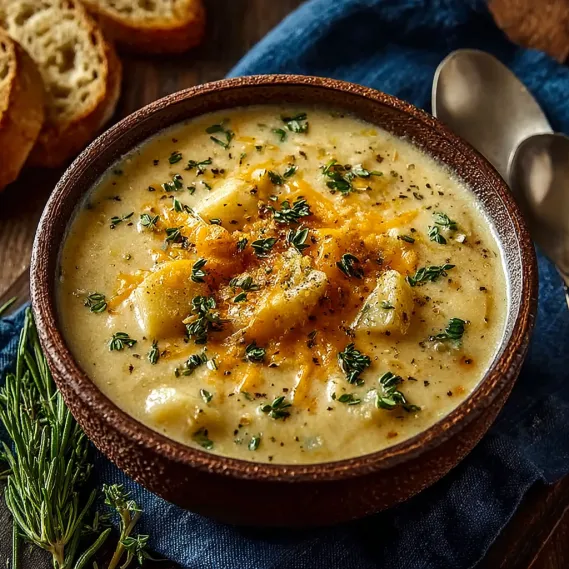 Pin
Pin
This hearty cheddar garlic herb potato soup has become my ultimate comfort dish for those cold winter evenings. The velvety texture paired with savory garlic and fresh herbs creates a restaurant-quality soup using simple ingredients from your pantry.
I first developed this recipe during a particularly harsh winter when my family was craving something warm and filling. What started as a simple potato soup experiment has now become our most requested meal when temperatures drop.
Ingredients
- Yukon Gold potatoes: chosen specifically for their buttery flavor and ability to break down perfectly for creamy soup
- Unsalted butter: provides rich flavor foundation while keeping sodium levels controlled
- Yellow onion and fresh garlic: create an aromatic base that enhances the overall depth
- All purpose flour: helps create the perfect silky texture without clumping
- Sharp cheddar cheese: freshly grated from a block melts beautifully and delivers maximum flavor
- Fresh herbs including parsley chives and thyme: add brightness and color contrast
- Whole milk and heavy cream: provide luxurious mouthfeel and richness
Step-by-Step Instructions
- Prepare the Potatoes:
- Uniform half inch cubes ensure even cooking and the perfect texture. Rinsing removes excess starch which prevents that gummy consistency nobody enjoys. Take time to cut pieces consistently as this significantly impacts the final texture.
- Sauté the Aromatics:
- This critical flavor building step requires patience. Cook onions until completely translucent but not browned which takes a full 5 to 7 minutes. The onions should become soft and almost melt into the background of the soup rather than standing out as distinct pieces.
- Add the Garlic:
- Fresh garlic needs just 1 to 2 minutes to release its essential oils and become fragrant. Watch carefully during this step as garlic can burn quickly and develop bitter flavors that will ruin your soup.
- Create the Roux:
- The flour must be cooked for the full 1 to 2 minutes while stirring constantly. This removes the raw flour taste and creates the thickening agent that gives your soup body. The mixture will look slightly paste like and golden.
- Introduce the Liquids:
- Adding broth gradually while whisking prevents lumps from forming. Use a wooden spoon to scrape the flavorful fond from the bottom of the pot incorporating those concentrated flavors into your soup base.
- Cook the Potatoes:
- Simmering gently rather than boiling maintains the integrity of the potatoes. Test for doneness by easily piercing with a fork. The potatoes should yield without resistance but not completely fall apart.
- Blend for Creaminess:
- Partial blending creates the perfect balance between smooth and chunky textures. If using an immersion blender pulse in short bursts rather than continuous blending to maintain control over the consistency.
- Incorporate Dairy and Herbs:
- Keep the heat low to prevent curdling. The milk and cream should be at room temperature if possible to reduce temperature shock. Fresh herbs added at this stage retain more flavor and color.
- Melt the Cheese:
- Adding cheese off heat prevents it from becoming stringy or separating. Use room temperature cheese and add in small amounts for perfect incorporation. The residual heat from the soup will melt it perfectly.
- Season to Perfection:
- Final seasoning should happen after cheese is added since cheese contributes significant saltiness. Taste and adjust with small additions until perfectly balanced.

The secret to this soup lies in the Yukon Gold potatoes. I discovered their superiority after testing multiple potato varieties. Their naturally buttery flavor and perfect starch content creates a soup that maintains its velvety consistency even when reheated, unlike russets which can become grainy.
Storing Your Potato Soup
This soup will keep beautifully in the refrigerator for up to 4 days in an airtight container. The flavors actually develop and improve overnight as the herbs infuse more deeply into the base. When reheating, do so gently over medium low heat, stirring occasionally to prevent scorching. Add a splash of milk if needed to restore the original consistency.
For freezing, cool the soup completely before transferring to freezer safe containers. Leave about an inch of headspace for expansion. Freeze for up to 3 months. Thaw overnight in the refrigerator before reheating. The texture may change slightly but stirring vigorously while reheating will help recombine any separated elements.
Smart Substitutions
Make this soup your own with thoughtful substitutions that maintain the core character while accommodating dietary needs or pantry limitations. For a lighter version, replace the whole milk and cream with equal parts evaporated milk. The protein content helps maintain creaminess without excessive fat.
Dairy free versions work surprisingly well when using full fat coconut milk and a good quality plant based cheese. The natural sweetness of coconut complements the savory elements beautifully. For gluten free needs, substitute the all purpose flour with sweet rice flour or cornstarch slurry added later in the cooking process.
Serving Suggestions
Transform this soup from side dish to spectacular meal with thoughtful accompaniments. A rustic bread bowl creates an impressive presentation for guests. Simply hollow out a round sourdough loaf, toast the inside briefly, then fill with hot soup.
For toppings, consider contrasting textures like crispy bacon, toasted pumpkin seeds, or homemade croutons. A dollop of tangy sour cream or Greek yogurt adds brightness. For a complete meal, serve smaller portions alongside a crisp green salad with vinaigrette dressing to cut through the richness.
Common Questions About This Recipe
- → What type of potatoes work best?
Yukon Gold potatoes are preferred for their creamy texture and buttery flavor, but Russets can work if needed.
- → Can I use vegetable broth instead of chicken broth?
Yes, vegetable broth offers a lighter, vegetarian-friendly base that still delivers great flavor.
- → How can I make this soup extra creamy?
Incorporate heavy cream or half-and-half alongside whole milk, and be sure to blend part of the soup for silkiness.
- → Is it necessary to blend the entire soup?
No, blending only a portion yields a mix of creamy and chunky textures, ensuring both richness and heartiness.
- → Which cheeses melt best for this soup?
Freshly shredded sharp cheddar melts smoothly into the soup, giving a bold, tangy character without becoming grainy.
- → What garnishes pair well?
Top with extra cheese, sour cream, crumbled bacon, chives, parsley, or croutons for extra flavor and texture.
